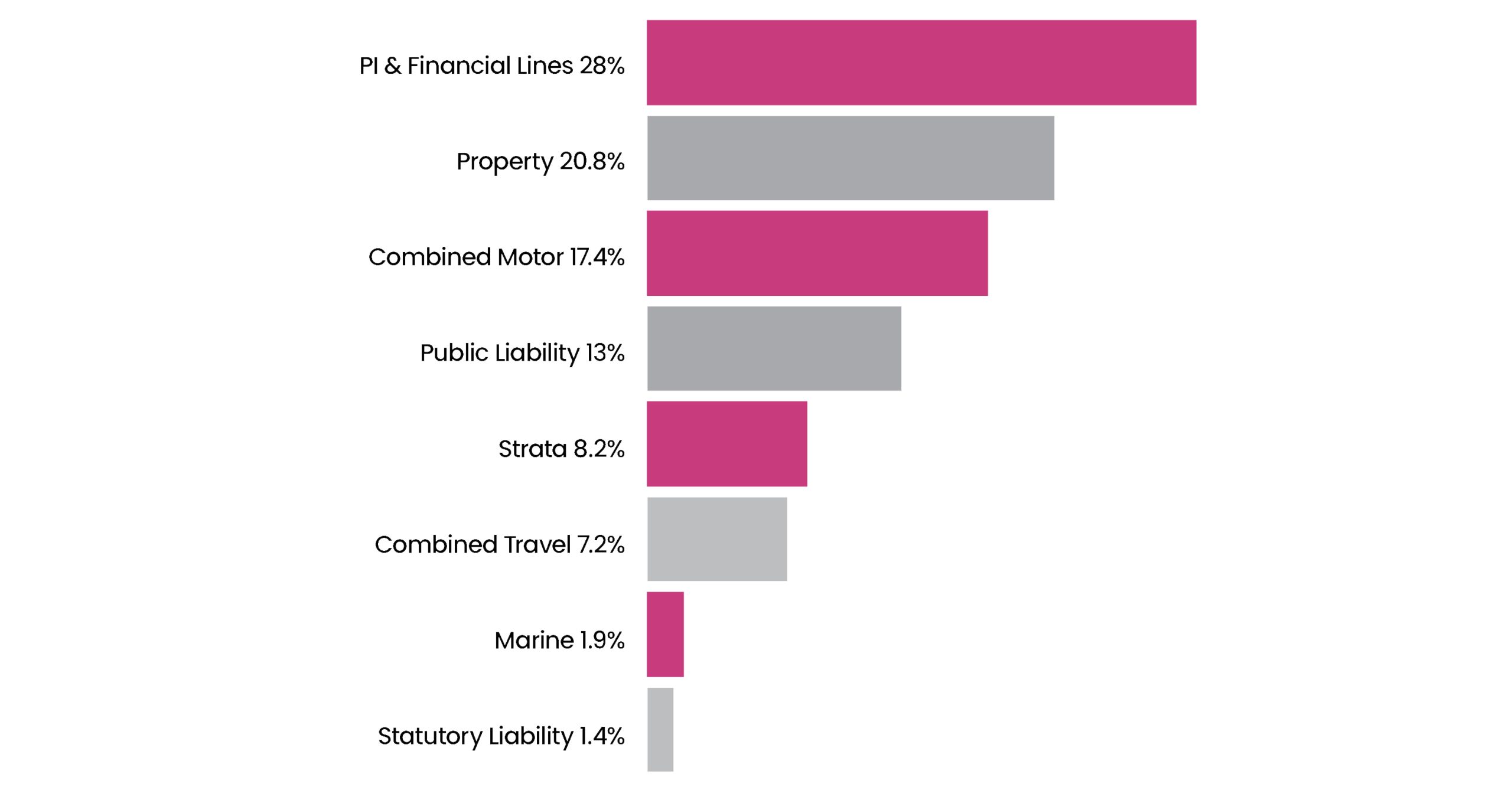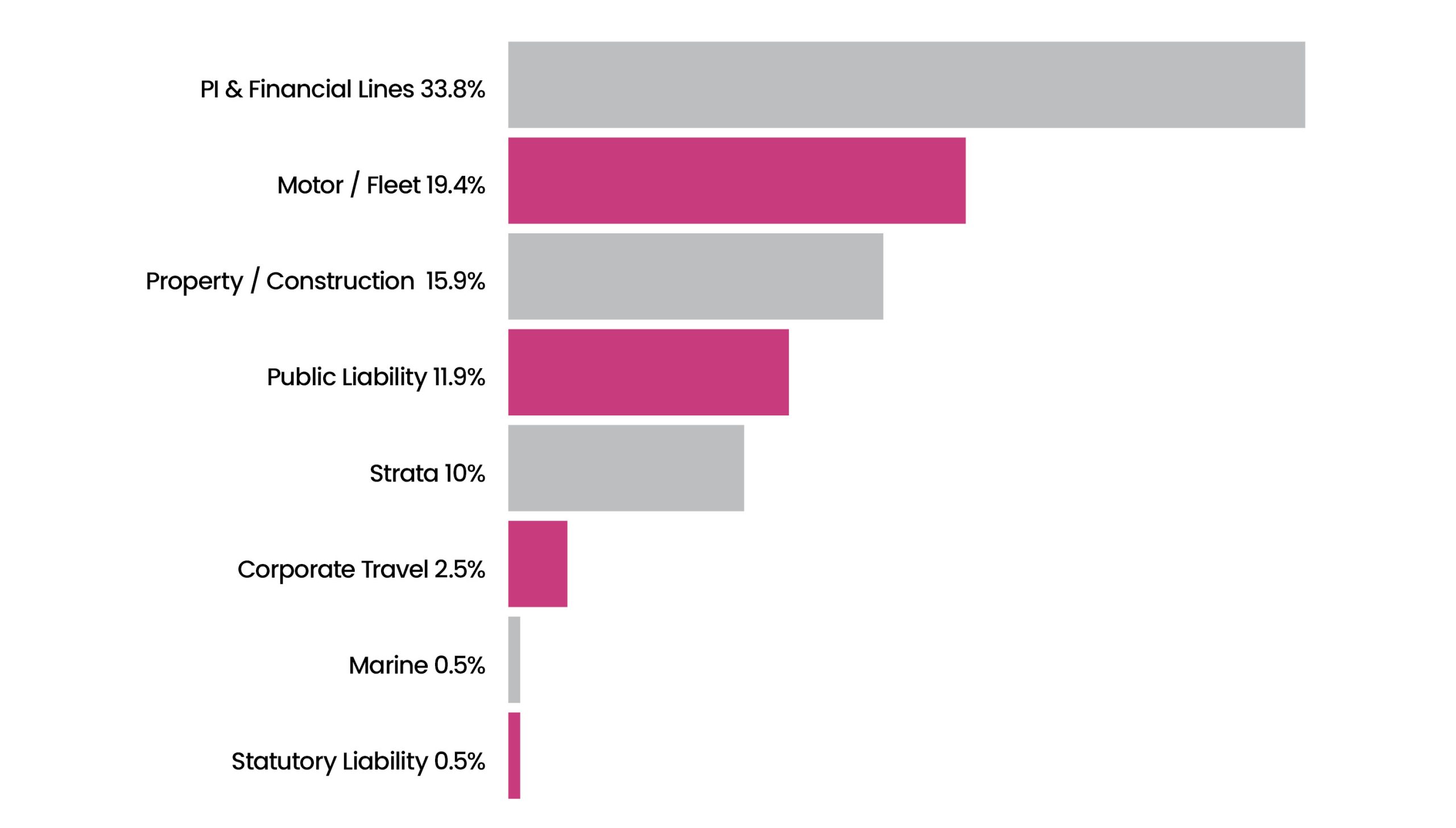July 2023 Market Update – Claims
The Bellrock claims department has seen further growth over FY23 with the expansion of our claims advocacy team. Our focus remains the proactive, hands-on management of claims on behalf of our clients from notification through to resolution. Some key statistics from this period include:
- Over $25,594,197.75 in claims currently managed by Bellrock NSW.
- An average of 18 claims settled on behalf of NSW clients per month.
- A total of $5,726,055.24 in claims settled across all insurance classes by Bellrock NSW over the past 12 months.
Over the course of FY23, the Bellrock NSW Team has assisted and advocated for clients, resulting in settlements and payments totalling $5.7M. Of this total, financial lines and property claims made up nearly half of payments. This breakdown is further illustrated in the graph below.
Claims paid by policy class, FY23 (Bellrock NSW)

With regard to new notifications over the past 12 months, professional indemnity and financial lines accounted for the largest claims, followed by motor/feet. A full breakdown is illustrated in the graph below.
New claims notifications by policy class, FY23 (Bellrock NSW)

Trends in claims
In terms of claims activity over the past 12 months, there continues to be a significant increase and awareness in terms of Cyber Liability Insurance (see our guide to Cyber Liability Insurance here).
In the Annual Cyber Threat Report 2022, published on 4 November 2022, the ACSC reported that it received over 76,000 cyber crime reports, an increase of nearly 13 per cent from the previous financial year.
As per ACSC data, there has also been a rise in the average cost per cyber crime reported to over $39,000 for small businesses, $88,000 for medium businesses, and over $62,000 for large businesses. An average increase of 14 per cent.
According to data published by the Office of the Australian Information Commission (OAIC) on 1 March 2023 (in terms of its Notifiable Data Breaches Report), data breaches were up 26 per cent, with the top 5 affected sectors being:
- Health service providers
- Finance (including superannuation)
- Insurance
- Legal, accounting & management services
- Recruitment agencies.
The OAIC report also found that for the period July 2022 to December 2022, that there was a 41 per cent increase in data breaches resulting from malicious or criminal attacks, with malicious and criminal attacks accounting for 70 per cent of all notifications, followed by Human Error (25 per cent) and System Fault (5 per cent).
As detailed in our December 2022 article an unprecedented rate of high profile cyber breaches have been observed over the last 12 months, impacting millions of everyday Australians.
- Optus data breach in September 2022
- Medibank – October 2022
- Telstra – December 2022
- HWL Ebsworth – April 2023.
Another area where increased activity has been observed is strata related claims. Aside from claims arising from some significant storm events throughout 2020/2021, we have also seen a notable increase of legal expenses claims in relation to disputes between lot owners and Building Management Committees as well as Owner’s Corporations. Additional claims have also arisen from renovations to Strata Buildings (including failure to agree planning permission). See our recent article on this topic here.
As discussed in our Construction update, for a period, construction contractors were not seen by insurers as a desirable sector – but that view is now starting to relax following premium increases in the past years. There remains a lower appetite from local markets in certain sectors (particularly residential high-rise development), however in other sectors this trend is reversing with project home builders and renovators generally seeing steady renewal outcomes and improved policy terms and conditions.
Notwithstanding the above, there continues to be increased scrutiny and claims activity in the construction industry, especially with regards to buildings with defects including those requiring cladding remediation.
As discussed in our article, additional challenges have also emerged in the building industry and consequently onto the insurers of building professionals and practitioners following the introduction of the Design and Building Practitioners Act 2020 (NSW).
As per previous market updates, Worker to worker claims (which commonly only appear 3 to 5 years following the incident) continue to impact claims frequency. See our article “Why worker to worker Claims are on the rise”.
- Property management
- EPL unfair dismissals
- Claims by regulatory groups
- Claims within the construction industry in terms of developments and product selection, defects and certification
- D&O claims for alleged ASIC and US Regulatory breaches.
As detailed in our recent article, ASIC v RI Advice, financial services licensees should expect further action from ASIC where there are failings in risk management.
Following on from our last market update, and detailed in our article here, there has been a continuation in terms of increased severity and frequency of major weather events, with the last 18 months seeing a continued onslaught of property claims primarily arising from severe weather and flood.
- February 2022 (Cat 221): On Monday 28 February 2022, the Insurance Council of Australia (ICA) declared an Insurance Catastrophe for Southeast Queensland and parts of NSW as a result of record-breaking severe weather and flooding which occurred between 22 February 2022 and 9 March 2022, with a reported 23 deaths.
Impacts: A total of over $5.92B in insured losses have been incurred to date incorporating 241,000 claims with an average payout of $23,000 with a current closure rate of 88.2%. This is the costliest flood in Australia’s history and fourth most costly disaster overall. The cost is over double that of the 2011 Brisbane flood, which saw $2.3B in insured losses.
- July 2022 (SE 222): On 5 July 2022, the ICA declared a “Significant Event” (SE) for the region of New South Wales. Whilst this flooding event most significantly impacted communities surrounding the Hawkesbury and Nepean Rivers, all regions impacted by flood fell under SE declaration. This was the fourth largest scale flood event for some Western Sydney communities over a two-year period.
Impacts: As per current data, a total of over $274M has been incurred to date, incorporating 23,000 claims, with a current closure rate of 84.6%.
- October 2022 (Cat 223): On 19 October 2022, the ICA escalated its significant event declaration to an Insurance Catastrophe for regions of Victoria, Tasmania and NSW impacted by severe weather and flooding since 12 October 2022.
Impacts: As per current data, a total of over $698M has been incurred to date, incorporating 22,000 claims, with a current closure rate of 67.2%.
Data shows that the cost of natural disasters is real, significant, and growing. Since the 2019–20 Black Summer bushfires, insurers have paid out more than $13B in natural disaster claims from 11 declared catastrophes. It is estimated that more than 9M Australians have been impacted by a natural disaster or extreme weather event over the last 30 years.
This is not just an issue that impacts those directly affected by extreme weather, but as per recent research undertaken by the McKell Institute for the ICA shows, the February–March floods cost each Australian household an additional $525 in premium.
Collectively governments, stakeholders and insurers must develop solutions to combat these growing challenges, giving consideration and priority to reducing greenhouse gas emissions and investing in resilience. This can only be done by identifying and adopting policies in the short, medium and long term to alleviate the dangers faced by local communities and the cost of rising insurance premiums.
On 9 February 2022, legislation for the Northern Australia Reinsurance Pool scheme for cyclones and related flood damage was introduced into the House of Representatives and was passed through the Senate on 30 March 2022.
As detailed in our article of 3 May 2022, the government implemented a reinsurance pool which was established on 1 July 2022 and backed by a $10B, annually reinstated, Commonwealth Guarantee, with over 880,000 small businesses, residential and strata insurance policies being eligible for this scheme. The pool operates Australia wide, but targets support to cyclone-prone areas, and provides reinsurance for insurers operating in those areas.
As discussed in our March 2023 article, ‘Social Inflation’ is becoming more relevant to businesses and their cost of insurance in advanced economies. This especially refers to claims costs rising at a greater rate than general inflation due to societal influence on the absorption of liability.
Continue reading our full range of market updates here:
For more in depth market updates by product class, profession and industry, please see our individual reports below:




